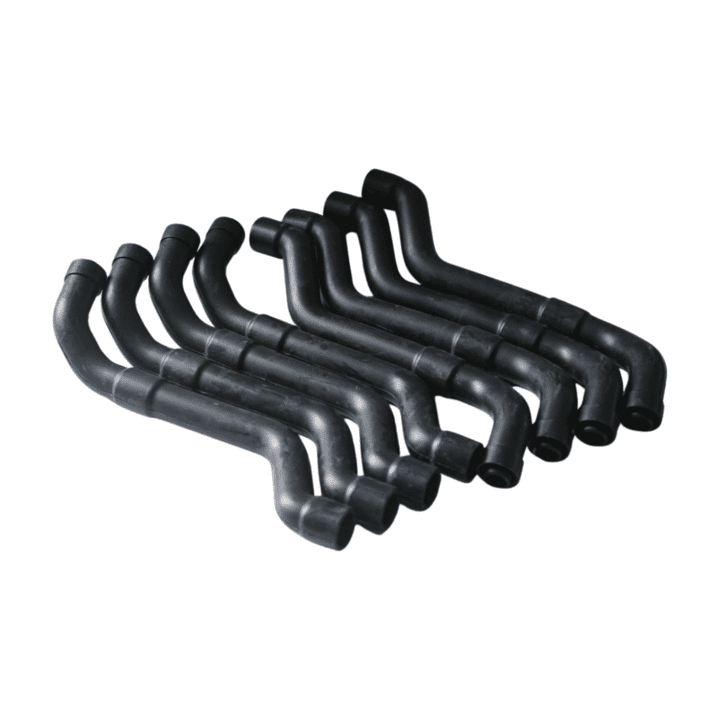Choosing the right material for a coolant hose is essential for ensuring efficient engine cooling and system performance. With several options available, let’s explore the best materials for coolant hoses and the factors that influence their suitability for your application.
The best material for a coolant hose depends on factors like temperature resistance, chemical compatibility, flexibility, and durability. Materials like silicone and EPDM are widely used, each offering unique advantages for specific applications.

The choice of material for your coolant hose is crucial for ensuring optimal system performance and longevity. Let’s take a closer look at the various materials commonly used for coolant hoses, their advantages, and where each one excels.
What Makes a Good Coolant Hose Material?
Before diving into specific materials, it’s important to understand what qualities make a material suitable for coolant hoses. Let’s take a look at the key characteristics needed for effective coolant hose performance.
A good coolant hose material must be resistant to high temperatures, flexible enough for installation, resistant to corrosion, and durable enough to withstand exposure to coolants and environmental factors.
Coolant hoses are designed to transport coolant fluid throughout the engine system, ensuring optimal temperatures for the engine and preventing overheating. The material used for coolant hoses must meet several critical requirements:
Temperature Resistance1: Coolant hoses are exposed to high temperatures, especially in automotive applications. A good material should maintain its structural integrity and flexibility under extreme heat without cracking, softening, or degrading.
Chemical Compatibility2: The material should be resistant to chemicals in the coolant, such as glycol, anti-freeze, and corrosion inhibitors. It should also resist degradation from oils and other automotive fluids.
Flexibility: A good coolant hose material should be flexible to ensure easy installation, even in tight spaces, and to accommodate the movements of the engine and surrounding components.
Durability3: The material must be able to withstand environmental factors, including UV exposure, ozone, and weathering, without deteriorating over time.
| Characteristic | Ideal Coolant Hose Material |
|---|---|
| Temperature Resistance | High (up to 250°C for silicone) |
| Chemical Resistance | High (resistant to coolant, oils, etc.) |
| Flexibility | Flexible and adaptable to movement |
| Durability | Long-lasting in harsh environments |
Common Materials for Coolant Hoses
Now that we know the essential qualities of a good coolant hose material, let’s explore the most commonly used materials in coolant hoses: EPDM, silicone, and rubber.
EPDM, silicone, and rubber are the most common materials used for coolant hoses, each offering different benefits depending on the specific application requirements.

EPDM Rubber for Coolant Hoses
EPDM (Ethylene Propylene Diene Monomer) rubber is one of the most widely used materials for coolant hoses, thanks to its durability and resistance to environmental factors. Let’s explore why EPDM is a popular choice.
EPDM rubber hoses offer excellent resistance to heat, ozone, and weathering, making them ideal for automotive and industrial coolant applications where moderate temperature resistance is needed.
EPDM rubber4 is a synthetic material that is highly resistant to heat, ozone, UV light, and weathering. It can withstand temperatures up to 150°C, making it an ideal choice for general automotive, industrial, and HVAC applications where coolant temperatures are moderate.
EPDM hoses also provide excellent resistance to many chemicals, including anti-freeze, coolant, and oils, making them a reliable option in systems where exposure to various fluids is common. However, EPDM’s performance can decrease in extremely high-temperature environments, which is where silicone excels.
| Property | EPDM Rubber | Other Rubber Types |
|---|---|---|
| Temperature Resistance | Moderate (up to 150°C) | Varies |
| Ozone & Weather Resistance | High | Varies |
| Durability | Good (especially in outdoor conditions) | Varies |
| Chemical Resistance | Good (resistant to coolant, oils) | Varies depending on material |
Silicone Rubber for Coolant Hoses
Silicone rubber5 offers excellent high-temperature resistance and is commonly used in applications where extreme performance is required. Let’s explore why silicone might be the best choice for some coolant hose systems.
Silicone coolant hoses can withstand higher temperatures and maintain their flexibility even at extreme heat, making them ideal for high-performance automotive and industrial applications.
Silicone rubber is known for its exceptional resistance to high temperatures, capable of withstanding up to 250°C in certain applications. This makes silicone an excellent choice for high-performance vehicles, industrial machinery, and other systems where temperatures exceed the capabilities of EPDM rubber.
Silicone hoses are highly durable, resistant to UV light, ozone, and extreme weather conditions, and maintain their flexibility over time. They also have superior resistance to chemicals, which makes them ideal for use in systems exposed to various automotive fluids, including coolants, oils, and antifreeze.
However, silicone hoses tend to be more expensive than EPDM hoses, and their flexibility may be less suitable for systems with tight bends or where high mechanical stress is involved.
| Property | Silicone Rubber | EPDM Rubber |
|---|---|---|
| Temperature Resistance | Excellent (up to 250°C) | Moderate (up to 150°C) |
| Chemical Resistance | Excellent (resistant to most chemicals) | Good (resistant to coolant, oils) |
| Durability | Long-lasting in extreme conditions | Good in outdoor conditions |
| Cost | Expensive | Affordable |
Rubber for Coolant Hoses6
Rubber hoses, while not as specialized as EPDM or silicone, can also be used in coolant systems. Let’s take a look at how traditional rubber compares to other materials for coolant hoses.
Rubber hoses are cost-effective and flexible but lack the high-temperature resistance and durability of EPDM or silicone hoses. They may be suitable for less demanding applications.

Traditional rubber hoses are commonly used in lower-cost, less demanding applications. They provide flexibility and are affordable, making them suitable for basic automotive or industrial systems where high-temperature or harsh environmental resistance is not required.
However, rubber hoses do not perform as well in extreme temperatures as EPDM or silicone. They also tend to degrade faster under prolonged exposure to UV light, ozone, and high heat, which limits their longevity in high-performance systems.
| Property | Rubber | EPDM Rubber | Silicone Rubber |
|---|---|---|---|
| Temperature Resistance | Moderate (up to 120°C) | Moderate (up to 150°C) | Excellent (up to 250°C) |
| Flexibility | Good | Good | Excellent |
| Durability | Less durable in extreme conditions | Good (especially in outdoor conditions) | Excellent in extreme conditions |
| Cost | Low | Affordable | Expensive |
Conclusion
Choosing the best material for a coolant hose depends on the specific requirements of your application. If you need a hose that can withstand extreme temperatures and perform in harsh conditions, silicone is the superior choice, although it comes at a higher cost. For standard applications where cost is a factor and moderate temperature resistance is required, EPDM is an excellent choice. Rubber hoses offer flexibility and affordability but may not be suitable for high-performance or extreme conditions.
🚀 Need Custom Coolant Hoses for Your Industry?
Contact Julong Rubber today or Request a Custom Quote for high-quality custom hoses tailored to your needs!
Understanding temperature resistance helps ensure the right material is chosen for engine performance and longevity. ↩
Exploring chemical compatibility ensures that the coolant hose will withstand various automotive fluids without degrading. ↩
Learning about durability can guide you in selecting hoses that last longer and perform better in harsh conditions. ↩
Explore the advantages of EPDM rubber, including its durability and resistance to environmental factors, ideal for coolant applications. ↩
Learn why silicone rubber is favored for high-temperature applications, offering superior flexibility and chemical resistance. ↩
Discover the cost-effectiveness and flexibility of rubber coolant hoses, and understand their limitations in extreme conditions. ↩






